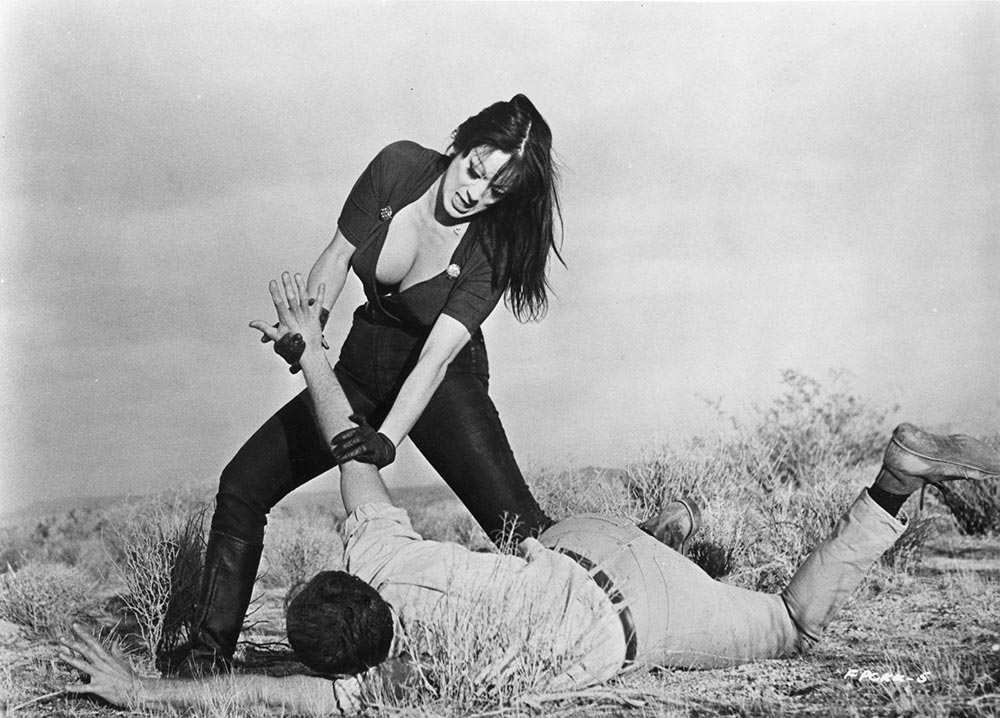“Ladies and gentlemen, welcome to violence.” That’s how an unseen narrator opens Russ Meyer’s sexploitation classic Faster, Pussycat! Kill! Kill! (1965), which continues to tantalize and delight almost six decades after its initial release. Produced as a gender-swapped follow-up to Meyer’s successful Motorpsycho (also released in 1965), Faster, Pussycat! Kill! Kill! was a flop. Critics dismissed it as cheap T&A even though it’s one of Meyer’s least racy movies, and audiences didn’t quite know what to make of the tough women at the center of the film, especially the perpetually pissed off and acid-tongued star Tura Satana. However, it’s these qualities, along with its subversively feminist spirit, that made the film into a cult classic.
When Faster, Pussycat! Kill! Kill! introduces its anti-heroes, they’re feverishly gyrating onstage at a go-go club while the men watching them snivel and slobber at their feet. As soon as their shift ends, the trio embark on a violent crime spree in the Mojave Desert (for no apparent reason) robbing, kidnapping, and murdering for thrills. They are led by the cat-eyed and raven-haired Varla (Satana), who karate-chops a drag racer to death and abducts his innocent girlfriend. Eventually, the group of women learn from a gas station attendant that there’s an old man living with his two sons and a hoard of cash in a run-down house nearby, so they track the family down with the intention to seduce them and steal their money. Sex and violence erupt as the women tease and terrorize men through an admittedly thin plot, but the performances and dialogue are so fun that the film’s charisma makes it all work.
A true B-movie auteur, Meyer not only wrote and directed his movies, but also frequently photographed, edited, and distributed them. From his early “nudie cuties” (The Immoral Mr. Teas, 1959), up through his melodramas (Good Morning and…Goodbye!, 1967), and even during his brief stint in Hollywood (Beyond the Valley of the Dolls, 1969), Meyer’s work was always defined by his preoccupation with buxom women who wielded sexual power over men. Faster, Pussycat! Kill! Kill! is no exception, except that the actual sexual content is tame by both the genre and Meyer’s standards, and the feminine bodies on display are always in control. There are plenty of breasts, but they are wielded like firearms, more intimidating than titillating. When the camera looks up at Santana as she stands proudly and sneers, with her chest aimed at her victims, she might as well be Dirty Harry.
Even if you’ve never seen Faster, Pussycat! Kill! Kill! you've likely encountered its far-reaching influence elsewhere in pop culture—traces of the film’s dialogue and visuals are everywhere from heavy metal songs and music videos to The Simpsons. It’s also woven into the sensibilities of other American auteurs like Quentin Tarantino and John Waters. In his book, Shock Treatment, the latter wrote, “Faster, Pussycat! Kill! Kill! is, beyond a doubt, the best movie ever made. It is possibly better than any film that will be made in the future.” That’s high praise from the Pope of Trash himself, but if there’s a filmmaker deserving of such hyperbole it’s Russ Meyer.
Faster, Pussycat! Kill! Kill! screens tonight, June 17, at Nitehawk Williamsburg as part of the series “Be Gay, Do Crime Part II: The Villain Edit.” It will be introduced by historian and programmer Elizabeth Purchell and series co-programmer Shayna Maci Warner.



